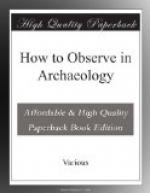For plaster casts of coins the face should be dusted with French chalk, as also a smooth bed of plasticine; the coin can then be pressed in safely without any possible risk, and afterward plaster cast in the mould. Sealing-wax is said to be sharper, but there is a risk of its sticking to the coin. If it is used, breathe hard on the coin, or wet it, before impressing; and when first set lift it slightly to detach it, and then replace till cold. Or tin-foil may be used, as in making positives; but, instead of floating on water, press plasticine on the foil while it is still on the object.
For curved surfaces, as cylinders, any of these methods can be used; the plasticine is the more successful.
In all casting of plaster on a small scale, use a soft camel-hair brush. Mix the plaster in the palm of the hand with a knife, take up some of the wettest to brush over the face of the moulds (a dozen scarabs or small coins done at once); then put he brush in water, and take up thicker plaster with a pocket-knife to drop on as a backing. This avoids air bubbles without using too weak a plaster.
Copying hieroglyphic inscriptions. Where possible a wet or a dry squeeze should be taken of any inscription. When hand copying is necessary, the main matter is to get the cartouches of king’s names accurately, and the date at the beginning, examining specially whether single strokes, I I I I, have been connected above, n n, forming the ten sign. The main difficulty for any one not knowing the 800 signs is to distinguish between those that are alike, especially when damaged. For this purpose the commonest signs that may be confused are here placed together, so that the essential points of difference may be noticed. A small cross is placed here by small points of distinction which might escape notice.
[Illustration I: Some hieroglyphic signs liable to be confused with each other]
6. Photography.
The camera and material have been described under outfit.
Lighting and preparation of objects is a main element of success. When first looking over any ruins, make a list of every view wanted, with the time of day when the sun will be right for it. Then follow the time-table, and so get the best lighting all in one day.
For movable stones or figures place them in half-shade, as a doorway, and then tilt every way until the best lighting is found, fix them in that position, and then set up the camera square with them.
The camera should usually be fixed to look downward vertically, and then variation up to 40 degrees can be got by the legs. Hold the camera in the right position, keeping the legs off the ground, and then drop the legs to find their own place; thus very skew positions can be fixed quickly.




